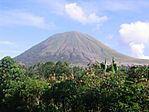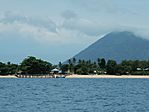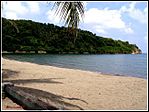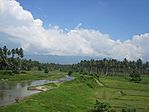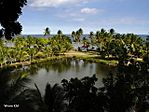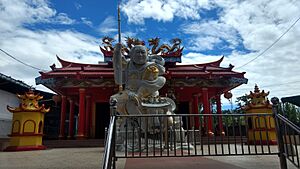North Sulawesi facts for kids
Quick facts for kids
North Sulawesi
Sulawesi Utara
|
|||
|---|---|---|---|
|
Clockwise, from top left : The view of Mount Tumpa from Malalayang Beach, Mount Lokon, Lake Tondano, Teluk Buyat Beach, Bentenan Beach, A landscape in North Sulawesi, Bunaken and Manado Tua.
|
|||
|
|||
| Motto(s):
Si Tou Timou Tumou Tou (Minahasan)
(Human purpose in life is to nurture and educate others) |
|||
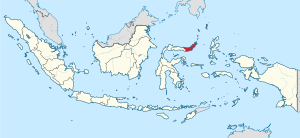
North Sulawesi in Indonesia
|
|||
| Country | Indonesia | ||
| Established | 14 August 1959 | ||
| Founded by | Sam Ratulangi | ||
| Capital and largest city |
Manado | ||
| Government | |||
| • Body | North Sulawesi Regional Government | ||
| Area | |||
| • Total | 13,851.64 km2 (5,348.15 sq mi) | ||
| Area rank | 27th | ||
| Highest elevation | 1,995 m (6,545 ft) | ||
| Population
(mid 2019)
|
|||
| • Total | 2,512,900 | ||
| • Density | 181.415/km2 (469.864/sq mi) | ||
| People | |||
| • Ethnic groups | Minahasan, Mongondow, Sangirese, Talaud, Gorontaloan, Chinese, Bugis, Javanese | ||
| • Religion | Protestantism (63.6%), Roman Catholicism (4.4%), Islam (30.9%), Hinduism (0.58%), Buddhism (0.14%), Confucianism (0.02%), Judaism | ||
| • Languages | Indonesian (official) Manado Malay (lingua franca) Regional languages: Bantik, Bintauna, Mongondow, Ratahan, Sangirese, Talaud, Tombulu, Tondano, Tonsawang, Tonsea, Tontemboan |
||
| Time zone | UTC+8 (Indonesia Central Time) | ||
| Postcodes |
90xxx, 91xxx, 92xxx
|
||
| Area codes | (+62) 4xx | ||
| ISO 3166 code | ID-SA | ||
| Vehicle registration | DB, DL (Sangihe & Talaud Islands) | ||
| HDI | |||
| HDI rank | 7th (2018) | ||
| Largest city by area | Bitung – 302.89 square kilometres (116.95 sq mi) | ||
| Largest city by population | Manado – (432,300 in 2019) | ||
| Largest regency by area | Bolaang Mongondow Regency – 2,871.65 square kilometres (1,108.75 sq mi) | ||
| Largest regency by population | Minahasa Regency – (341,500 in 2019) | ||
North Sulawesi (which means Sulawesi Utara in Indonesian) is a province in Indonesia. It's located on the northeastern part of Sulawesi island, on a piece of land called the Minahasa Peninsula. To its north are the Philippines, and to its southeast is Sabah, Malaysia.
The Molucca Sea is to the east. The Celebes Sea and Gorontalo province are to the west. The Gulf of Tomini is to the southwest. North Sulawesi covers about 13,851 square kilometers. In 2010, about 2.27 million people lived there.
The capital city, business hub, and largest city is Manado. Other important towns include Tomohon and Bitung. The province has many tall mountains, some reaching almost 2,000 meters high. It is a volcanic region, meaning there are active volcanoes and eruptions sometimes happen.
In the past, different European countries and local kingdoms fought for control of North Sulawesi. They wanted its valuable resources like spices, rice, and gold. This area was also an important trading route between the East and West. This helped different religions like Christianity and Islam spread. The Portuguese were the first Europeans to arrive in the 1500s. The Spanish and Dutch also came and fought for control. The Dutch finally gained control in the 1600s. They ruled for about 300 years until the Japanese took over during World War II. After Japan lost the war in 1945, the Dutch briefly returned. They left for good in 1949, and North Sulawesi became part of the new country of Indonesia. The province of North Sulawesi was officially formed on August 14, 1959.
Contents
What's in a Name?
The area around North Sulawesi was often called Minahasa. This name is still used today. The word Minahasa comes from "Mina-Esa" or "Maesa." These words mean "being one" or "uniting."
This name shows a hope for different local groups to come together. These groups include the Tontemboan, Tombulu, Tonsea, Tolour (Tondano), Tonsawang, Ponosakan, Pasan, and Bantik. The name "Minahasa" was first used by a Dutch official named J.D. Schierstein in 1789.
A Look Back in Time
Early History
Scientists have found signs of human life in North Sulawesi from as far back as 30,000 years ago. Evidence was found in a cave on Salibabu island. Other discoveries show people lived here about 6,000 years ago near Kakas District. More recent findings, from 4,000 years ago, were found in a cave on Karakelang Island.
Colonial Times
In the late 1500s, Portuguese and Spanish ships arrived in North Sulawesi. The Portuguese were the first Westerners to land in Manado. At that time, a kingdom called the Sultanate of Maguindanao controlled the northern islands. The Portuguese built a fort in Amurang.
Spanish ships also visited islands like Talaud and Siau. Spain built a fort in Manado, and soon the Minahasa area came under Spanish control. People in Minahasa fought against Spanish rule from 1660 to 1664.
The Dutch arrived in Manado in 1660. They helped the Minahasa people fight against Spain. The Minahasa leaders made a trade agreement with the Dutch trading company, the VOC. This agreement allowed the VOC to control most of the trade. Over time, the Dutch started to force their will on the locals. This led to resistance in the 1700s and a war between the Dutch and Minahasa people in Tondano from 1809 to 1811.
Spain had already taken control of the Philippine Islands. They turned Minahasa into a coffee growing area. Manado became a center for coffee trade with Chinese merchants. Some Minahasan tribes even helped Spain capture the Portuguese fort at Amurang in the 1550s. After that, the Spanish built their own fort in Manado and eventually controlled all of Minahasa.
In the 16th century, Manado became home to one of the first mixed European and Asian communities. The first king of Manado, Muntu Untu (who ruled around 1630), was half Spanish. Spain later gave Minahasa to the Portuguese in exchange for money. However, Minahasa leaders worked with the Dutch to force the Portuguese out. They succeeded in 1655. They built their own fort in 1658 and the last Portuguese left a few years later.
By the early 1600s, the Dutch had weakened the power of Spain and Portugal in the region. In 1677, the Dutch took over the Sangir islands. Two years later, a Dutch governor visited Manado. He made an agreement with the Minahasan chiefs. This agreement gave the Dutch control for the next 300 years. However, the Dutch only started direct rule in 1870.
The Dutch helped unite the Minahasa groups. In 1693, the Minahasa people won a battle against the Mongondow tribe to the south. Dutch influence grew, and Christianity and European culture became more common in Minahasa. Missionary schools in Manado, started in 1881, were some of the first attempts at widespread education in Indonesia. People who graduated from these schools could find jobs in the government or army.
Even though the Dutch and Minahasa became very close, there were still conflicts. There was a war between the Dutch and Tondano in 1807 and 1809. Minahasa was not under direct Dutch rule until 1870. Because of their close ties, Minahasa was sometimes called the "12th Dutch province." In 1947, a group in Manado even wanted Minahasa to formally become part of the Netherlands.
Becoming Independent
The Japanese took control of the area from 1942 to 1945. This was a difficult time, and Allied forces heavily bombed Manado in 1945. After Indonesia gained independence, there were disagreements in Minahasa. Some people supported Indonesia, while others wanted to stay with the Dutch.
When Sam Ratulangi was appointed as the first governor of East Indonesia, he helped gain Minahasa's support for the Republic of Indonesia. After Indonesia became independent, it was divided into 8 provinces. Sulawesi was one of them. S.G.J. Ratulangi, a national hero, was Sulawesi's first governor. In 1948, the State of East Indonesia was formed in Sulawesi. This state later joined the Republic of Indonesia. North Sulawesi Province was officially formed on August 14, 1959.
In 1957, military leaders in North and South Sulawesi asked for more freedom from the central government in Java. They wanted more development, fair sharing of tax money, and help against a rebellion in South Sulawesi. They also wanted a central government led equally by Sukarno and Hatta. This movement was called 'Permesta'. At first, it was about making reforms, not about breaking away.
Talks between the government and Sulawesi leaders stopped violence in South Sulawesi. But Minahasan leaders were not happy with the outcome. They declared their own North Sulawesi autonomous state in June 1957. The central government then sent military help to stop the uprising. The Permesta forces were defeated. The Permesta uprising ended in mid-1961.
The rebellions in Sumatra and Sulawesi failed. They actually made the central government stronger. The central government gained more power, and local areas had less freedom. After these events, Indonesia started to adopt laws that give more power to local regions. This was one of the main ideas the Permesta movement fought for.
Environment
Climate
North Sulawesi has a tropical climate with monsoon winds. From November to April, west winds bring rain to the north coast. From May to October, dry south winds blow. The area gets about 2,000 to 3,000 millimeters of rain each year. There are usually 90 to 140 rainy days. The average temperature is about 25 degrees Celsius. The highest average temperature recorded was 30 degrees Celsius, and the lowest was 22.1 degrees Celsius.
Geography
North Sulawesi Province is on the northern part of Sulawesi Island. It is one of Indonesia's three provinces located in important areas on the Pacific Rim. North Sulawesi is close to the equator. It stretches from about 0.30 to 4.30 degrees North Latitude and 121 to 127 degrees East Longitude. The peninsula extends from east to west. The Sangihe and Talaud Islands are the northernmost parts of the province.
Here are North Sulawesi's neighbors:
| North | Celebes Sea, Pacific Ocean and Philippines |
| South | Gulf of Tomini |
| East | Molucca Sea, Maluku and North Maluku |
| West | Gorontalo |
Most of mainland North Sulawesi is made up of mountains and hills. There are valleys in between them. Some of the mountains include Mount Klabat (1,895 m) in North Minahasa and Mount Lokon (1,579 m) in Tomohon. Other mountains are Mount Soputan (1,789 m) and Mount Dua Saudara (1,468 m). In the Sangihe and Talaud islands, you can find Mount Awu (1,784 m) and Mount Karangketang (1,320 m).
The two largest lakes are Lake Tondano (covering 4,278 hectares) in Minahasa and Lake Moat (617 hectares) in East Bolaang Mongondow. Important rivers include the Tondano River (40 km) and the Ranoyapo River (51.9 km) in Minahasa. The Dumoga River (87.2 km) is in Bolmong.
Along the coast of North Sulawesi, both on the mainland and the islands, there are many capes and bays. The soil in the area is very fertile, which is great for farming.
Plants and Animals
Many plants and animals in North Sulawesi are similar to those found in other parts of Indonesia. However, some unique animals live here. These include deer, the Maleo bird, and the tiny Tarsius Spectrum monkey. You can find the Tarsius in the Tangkoko nature reserve near Bitung City. The rare Coelacanth fish can also be found off the coast of Manado.
The seas around North Sulawesi are full of different fish, coral, and plankton. Some marine fish, like tuna, skipjack, yellow tail, and lobster, are important for trade.
Much of North Sulawesi is covered by forests. These forests grow from sea level all the way up to the mountain tops. They provide good quality timber, such as ebony, ironwood, and meranti. Farmers also grow crops like coconuts, nutmeg, and cloves.
People
| Religion in North Sulawesi (2010 Census) | ||||
|---|---|---|---|---|
| Religion | percent | |||
| Protestantism | 63.60% | |||
| Islam | 30.90% | |||
| Roman Catholicism | 4.40% | |||
| Hinduism | 0.58% | |||
| Not Asked | 0.29% | |||
| Buddhism | 0.14% | |||
| Others | 0.06% | |||
| Confucianism | 0.02% | |||
| Not Stated | 0.01% | |||
In 2010, North Sulawesi had 2,270,596 people. This was about 1.41% more than ten years before. The biggest groups of people are the Minahasa people in the north and the Mongondow people in the south. The main city is Manado, which had about 432,300 people in 2019.
In 2010, about 68% of the people were Christian. Most Christians in North Sulawesi are Protestant, but some are Catholic. This is special because most of Indonesia is Muslim. Dutch missionaries were very successful here during colonial times. Also, the mostly Muslim region of Gorontalo became its own province in 2000. There are also smaller groups of Muslims, Hindus, and Buddhists. Manado even has a small Jewish community. The only synagogue in Indonesia is in Manado. About 800 Jewish people live there.
Ethnic Groups
Many different groups of people live together in North Sulawesi. The largest group is the Minahasa people. They mostly live in cities like Bitung, Manado, and Tomohon. They also live in the Minahasa, North Minahasa, South Minahasa, and Southeast Minahasa Regencies. Other groups include the Bolaang Mongondow, Sangihe, Talaud, and Siau people.
North Sulawesi has more different ethnic groups than some other parts of Indonesia. The Minahasa and Bolaang Mongondow people live almost everywhere on the mainland. The Sangihe, Talaud, and Siau people mostly live on the Sangihe Islands, Talaud Island, and Lembeh Island. They are especially found in coastal areas. The Bajau people are sea nomads who came from the Sulu Archipelago in the Philippines. They moved because of conflicts in Mindanao. They live in coastal villages in the northern part of North Minahasa Regency.
Besides the native groups, many people have moved to North Sulawesi. There is a large Chinese population, especially in Manado. Chinese people were among the first to interact with local people before Europeans arrived. Old Chinese letters found in the Tompaso area show that Chinese and Minahasa cultures have been connected since the Han dynasty. Most Chinese people in North Sulawesi are Hakka, but some Hokkien and Cantonese people also live there.
Other groups like the Javanese and the Sundanese also live here. Many of them moved from other parts of Indonesia because of a government program called the Transmigration program. This program was started by the Dutch and continued until the Suharto era. These groups usually live in cities like Manado and Tomohon.
Languages Spoken
North Sulawesi is a place with many languages. People often speak at least two, and sometimes more. Indonesian is the official language. Government documents and road signs are all in Indonesian. However, most people use Manado Malay for everyday talks. This language is similar to Indonesian but has its own differences.
Minahasan people speak Minahasan languages. There are five main Minahasan languages: Tonsawang, Tontemboan, Toulour, Tonsea, and Tombulu. In the south, people speak Mongondow language and Gorontalo language. In the northern islands, close to the Philippines, people speak Visayan languages.
Other languages in North Sulawesi include Javanese, Sundanese, and Balinese. These are spoken by people who moved from other parts of Indonesia. Some Chinese people in Manado speak Hakka. Hokkien and Cantonese are also spoken. In places with many tourists, like Bunaken National Park, English and Mandarin are often understood. Older people might understand Dutch and Portuguese. People living on islands near the Philippines might understand Tagalog.
Administrative Divisions
North Sulawesi has eleven regencies (which are like counties) and four independent cities. They are listed below.
| Name | Area (km2) | Population Census 2010 |
Population Census 2015 |
Population Estimate 2019 |
Capital | HDI 2014 Estimates |
|---|---|---|---|---|---|---|
| Sangihe Islands Regency (Kepulauan Sangihe) |
461.11 | 126,100 | 129,560 | 131,800 | Tahuna | 0.668 (Medium) |
| Sitaro Islands Regency (Kepulauan Siau Tagulandang Biaro) |
275.96 | 63,801 | 65,529 | 67,000 | Ondong Siau | 0.643 (Medium) |
| Talaud Islands Regency (Kepulauan Talaud) |
1,240.40 | 83,434 | 88,589 | 92,500 | Melonguane | 0.665 (Medium) |
| Northern (islands) sector | 1,977.47 | 273,335 | 283,678 | 291,300 | ||
| Bitung (city) | 302.89 | 187,652 | 205,379 | 220,700 | 0.708 (High) | |
| Manado (city) | 157.27 | 410,481 | 425,420 | 432,300 | 0.772 (High) | |
| Tomohon (city) | 114.20 | 91,553 | 100,193 | 107,600 | 0.735 (High) | |
| Minahasa Regency | 1,114.87 | 310,384 | 328,700 | 341,500 | Tondano | 0.727 (High) |
| North Minahasa Regency (Minahasa Utara) |
918.49 | 188,904 | 197,861 | 203,200 | Airmadidi | 0.705 (Medium) |
| South Minahasa Regency (Minahasa Selatan) |
1,409.97 | 195,553 | 204,832 | 210,400 | Amurang | 0.683 (Medium) |
| Southeast Minahasa Regency (Minahasa Tenggara) |
710.83 | 100,443 | 104,465 | 106,500 | Ratahan | 0.678 (Medium) |
| Eastern (Minahasa) sector | 4,728.52 | 1,494,970 | 1,566,850 | 1,622,200 | ||
| Kotamobagu (city) | 68.06 | 107,459 | 119,277 | 130,000 | 0.704 (High) | |
| Bolaang Mongondow Regency | 2,871.65 | 213,484 | 232,968 | 249,600 | Kotamobagu | 0.645 (Medium) |
| East Bolaang Mongondow Regency (Bolaang Mongondow Timur) |
910.18 | 63,654 | 68,622 | 72,600 | Tutuyan | 0.631 (Medium) |
| North Bolaang Mongondow Regency (Bolaang Mongondow Utara) |
1,680.00 | 70,693 | 76,264 | 80,700 | Boroko | 0.642 (Medium) |
| South Bolaang Mongondow Regency (Bolaang Mongondow Selatan) |
1,615.86 | 57,001 | 62,162 | 66,500 | Molibagu | 0.635 (Medium) |
| Western (Bolaang Mongondow) sector | 7,145.75 | 512,291 | 559,293 | 599,400 |
Images for kids
See also
 In Spanish: Provincia de Célebes Septentrional para niños
In Spanish: Provincia de Célebes Septentrional para niños


